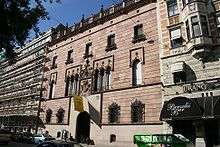Hallwyl Museum
| Hallwylska museet | |
|
Hallwylska palatset November 2011 | |
| Established | 1938 |
|---|---|
| Location | Hamngatan 4, 111 47 Stockholm, Sweden |
| Visitors | 100 829 (2013)[1] |
| Director | Heli Haapasalo |
| Public transit access | Metro: Östermalmstorg metro station (Stureplan exit) |
| Website | http://hallwylskamuseet.se/en |

Hallwyl Museum (Swedish: Hallwylska museet) is a Swedish national museum housed in the historical Hallwyl House in central Stockholm located on 4, Hamngatan facing Berzelii Park. The house once belonged to the Count and Countess von Hallwyl, but was donated to the Swedish state in 1920 to eventually become a museum. In 1938, the museum was officially opened.
History
Hallwyl House (Swedish: Hallwylska palatset) was built 1893–1898 to the design of Isak Gustaf Clason for Count Walther von Hallwyl and his wife, Wilhelmina. It was created to accommodate the office of the count and the extensive art collection of the countess. Wilhelmina and Walther von Hallwyl also lived there during the winter. While the exterior of the building and the court is historical in style — borrowing architectural elements from medieval prototypes and Renaissance Venice — it was utterly modern on its completion — including electricity, central heating, telephones, and bathrooms. The elevator was a later addition.
The countess collected her artworks during her worldwide journeys in order to found a museum, and, consequently, the palace was donated to the Swedish State in 1920, a decade before her death. The museum, including many of the rooms where they used to live, opened in 1938 to the public.[2]
Hallwyl Museum, in association with Skokloster Castle and the Royal Armoury, is part of a government agency known as the Royal Armoury and Skokloster Castle with the Hallwyl Museum Foundation, or Livrustkammaren och Skoklosters slott med Stiftelsen Hallwylska museet (LSH) in Swedish.[3]
| Wikimedia Commons has media related to Hallwyl Museum. |
Collections
Hallwyl House was donated to the Swedish state on the condition that it would remain unchanged. Today, the house has been preserved as it was when Countess von Hallwyl donated the house. The museum features preserved rooms from the late Victorian period in Sweden giving a glimpse into the lifestyles of the nobility in Stockholm at the time.[4]
The Hallwyl Collection, which is housed there, encompasses some 50,000 objects.[5]
 The silver room
The silver room The gallery
The gallery The kitchen
The kitchen The smoking room
The smoking room Christmas at the museum
Christmas at the museum The diningroom
The diningroom
See also
References
- ↑ Museer 2013: Kulturfakta 2014:1 (PDF). Stockholm, Sweden: Myndigheten för kulturanalys. 2014. p. 28. ISBN 978-91-87046-15-5. Retrieved 11 October 2014.
- ↑ "The Hallwyl House". www.hallwylskamuseet.se. Retrieved 10 October 2014.
- ↑ "A government agency". www.hallwylskamuseet.se. Retrieved 10 October 2014.
- ↑ "The Hallwyl House". www.hallwylskamuseet.se. Retrieved 11 October 2014.
- ↑ "Edwardian England on display in Stockholm". www.thelocal.se. Retrieved 11 October 2014.
- Johan Mårtelius (1999). "Norra innerstaden". Guide till Stockholms arkitektur (2nd ed.). Stockholm: Arkitektur Förlag AB. p. 93. ISBN 91-86050-41-9.
External links
Coordinates: 59°19′59″N 18°04′28″E / 59.33296°N 18.074516°E
